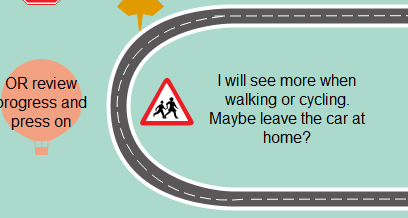Sometimes they are.
Normally I encourage you to dip in and out of this web-site. On this page there are a number of links to other parts of my site. On this occasion, I’d recommend taking your time to follow links. That way, you may feel confident about actions that are wise, and those best taken to a consultant.
You can see where taking time fits in to the scenic route, as a whole. Here’s an extract that asks you to consider your mode of transport on the scenic route.

Please do not rush to get informed when researching treatments for trauma-related symptoms.
Taking a step to toward safe experiments with trauma experiences
You are taking an important step and I want to use my own influence to ensure this research is done with great care. The findings of researchers and practitioners I mention on this page are well worth consulting.
Elvin Semrad was Bessel van der Kolk’s mentor as he trained in psychiatry in the States. In his book, The Body Keeps The Score (2014), van der Kolk quotes his mentor saying:
“The greatest sources of our suffering are the lies we tell ourselves“
…. going on to say that people never get better without knowing what they know, and feeling what they feel.
The Body Scan is a safe experiment to help explore what I know and to just notice what I feel.
To explain more, Semrad’s reference to “lies” was not a criticism of his patients. He was referring to specific post-trauma responses; to an apparent paradox in trauma work. Some people who experience trauma are able to initiate strong emotions and, in turn, those reactions appear to block other feelings – especially the pain connected to the event at the time, or shortly after.
So, the truth is: we can be our own worst enemy, without intended it
It’s as though there is value, for some, in reproducing strong emotions in order to block some pain; it is the lesser of two evils.
The theory is that the recall of events – and the associated strong emotions – released morphine-like substances manufactured in the brain. These provided some relief and become a ‘preferred’ strategy – rather than just noticing the event itself and all that went with it.
Therapy is helpful in finding alternative strategies to uncontrolled ‘revisiting’ of trauma. That is particularly so where the blocked ‘pain’ is more psychological, e.g. when deep shame and guilt lie behind our survival after any trauma.
Learning from Pavlov’s dogs
An example from van der Kolk might help. He tells of dogs traumatised in experiments by Ivan Pavlov (and others). On one occasion, the dogs were confined in a cellar flooded by a nearby river. Some dogs made no effort to escape from their cages, even when the doors were opened after the event.
It emerged that those dogs secreted excess amounts of stress hormones, such as adrenaline and cortisol – long after the danger had passed. This kept them ‘frozen’ in their cages and they appeared oblivious to the available escape route. There is more on different kinds of ‘immobilisation‘ on this page.
What we now know is that the body thrives only on release of short bursts of those morphine-like hormones when the threat is present. Longer term damage is created by persistent release of them – a series of rather large defeats that may not get just noticed.
The logic appears to be: that response worked in the short term; that’s good, so let’s keep it going.
In fact, the level of hormones needs to lessen steadily after any event if our system is to return to equilibrium. You will see the impala do this through shivering – on a YouTube video inserted into this page.
Hanging on to stress hormones does not help
Notice how the impala deals with stress.
Without shaking out those stress hormones, it was possible to create one indicator of trauma – the persistent retention of stress hormones. The video clip shows that one way to achieve change – to dissipate those hormones – was to act.
It required drastic action to break the immobility show by Pavlov’s dogs; namely, to “repeatedly drag them [the dogs] out of their cages so they could physically experience how they could get away“.
A good therapist will not do this …. but s/he can direct your efforts to the relevant safe experiments. The value of ‘safe experiments’ encouraged by therapists has emerged from decades-old observations.
It pays to act, to get out, and to do something.
Even so, I repeat that the design of experiments with professional support is sometime important. Your own actions are not all that might be required.
Another reason for using professional support is that safe experiments cannot be guaranteed to produce small victories. Indeed, treating trauma by small safe experiments may – unintentionally, or not – generate potentially large defeats, known as ‘re-traumatisations’. They can appear unexpected and competent professional support can help to contain them.
Such defeats can arise because we take unskilled actions when we try something different. How long did it take you to ride a two-wheel bike?
Trauma treatment may not be common-sense, but it is do-able.
